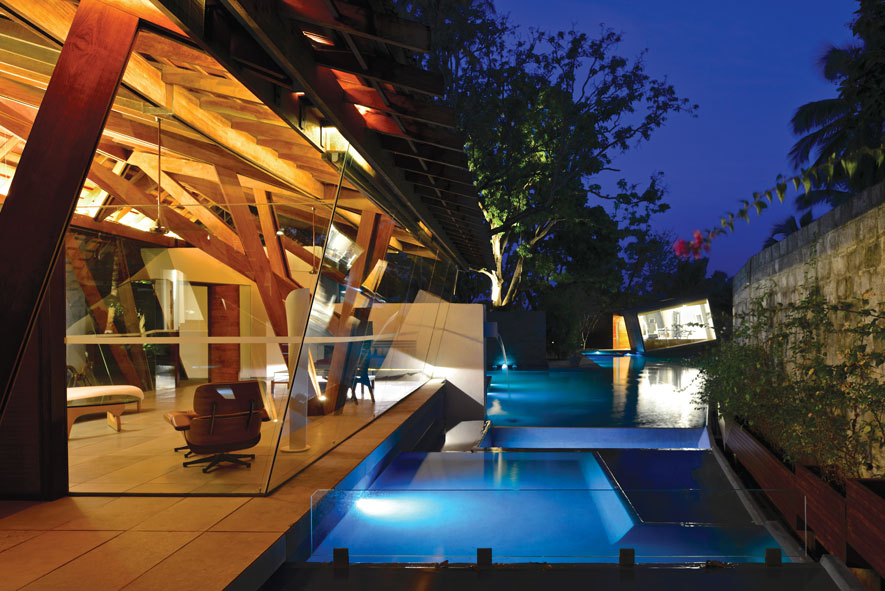
The house is interconnected with multiple water bodies and channels and a hierarchy of traditional Indian spaces through a series of courts
Project: Residence
Location: Sasavne, Alibaug
Site Area: 2.15 acre (+0.15 acre)
Project Area: 22,380 sq.ft.
Architect: Malik Architecture, Mumbai
Design Team: Kamal Malik, Amit Modi, Sunil Gavane, Rucha Pimprikar, Ketan Chaudhary
Status: Completed in 2013
Civil Contractor: Unique Construction Technologies
Structural Engineer: Strudcom
Plumbing Consultant: Suhas Gangan
Rain Water Harvesting: Mungekar and Associates
Landscape Consultant: Design Consultans, Taera Chowna
Structure and Civil: Unique Construction Technologies
Glazing: Unique Construction Technologies
Cladding: Vijaynath Interior & Exteriors Pvt.Ltd
HVAC: Cool Air Systems
Plumbing: Khodiyar
Firefighting: Khodiyar
Electrical: Parth Electricals
Pools and Water Bodies: Silver Pools
Photo Credits: Bharath Ramamrutham
The challenge was to construct the building with minimum impact on the abundant flora and fauna surrounding the site. In fact, the design concept was determined by the deeply forested site itself, and the architects were simply, the catalysts. To further reduce carbon footprint, the architect used four traditional materials in the main construction. Of these, three (stone, wood and clay tile) had been used in the region for centuries, while the fourth (fly-ash for blocks) was produced locally.
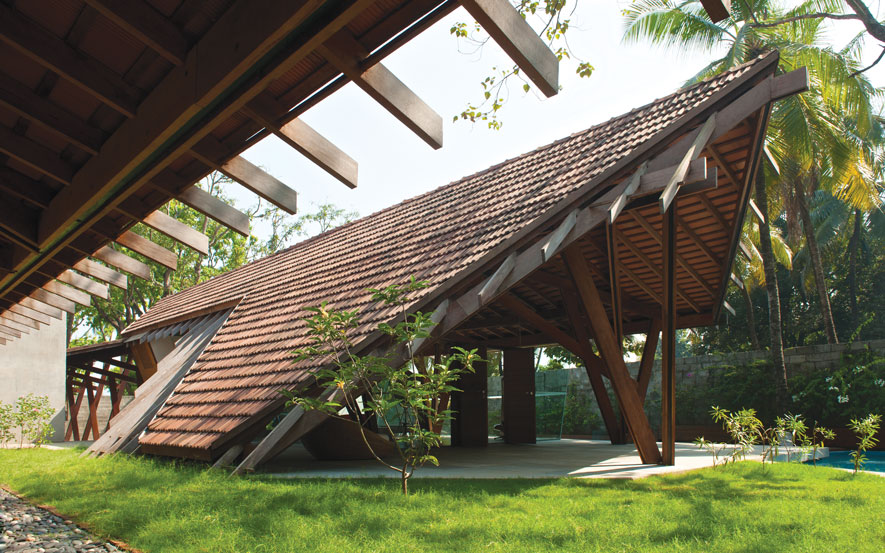
Since a thick forest covered the site, 'bald' spots were selected for constructing the building, so there was minimum relocation or cutting of trees. In addition, site levels were maintained to avoid losing top soil and flow of water through gravity.
Construction has been carried out using fly-ash cavity walls, wood and Mangalore tiles. The flooring is of natural (local) stones. Based on their experience of working in the region, the team used 'cavity' block walls and stones for the load bearing elements, and for the super-structure they used wood and Mangalore (clay) tiles. This was achieved by introducing a composite structural technology using thin steel plates sandwiched with wood planks. This opened up a fascinating window of achieving larger spans (yet using slender sections of wood) and also afforded them the ability to pick up the roof loads through numerous iterations and articulations. Considerable usage of wood was also thus reduced.
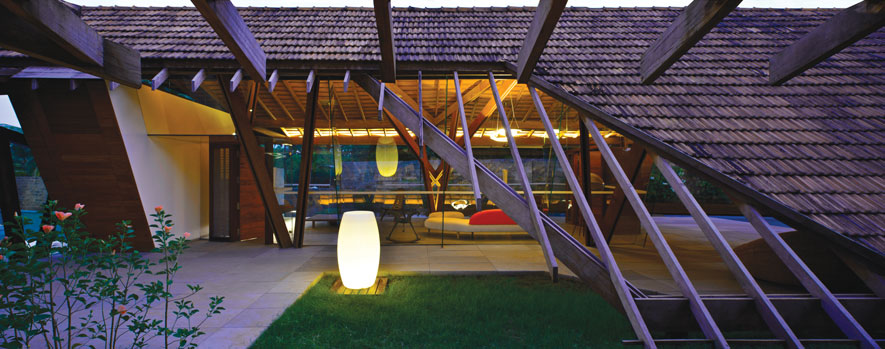
The 'scattered' components of the house were connected through an integrated network of water bodies and channels which were overlaid on the generated matrix. The process of layering ensured at every step that there was, at best, minimal intrusion on the forested site, and was achieved without disturbing Nature's equilibrium. The end result was a large house with interconnected multiple water bodies and channels and a hierarchy of traditional Indian spaces, from the formal to the private, through a series of courts.

The concept of the hamam has been derived from the stepped wells and Turkish baths. Circular openings in the slab allow natural daylight to enter the hamam and reflect in the pool. The sickaklik or hararet in a Turkish bath was traditionally provided with small glass windows in the domed ceiling to create subdued light. A straight flight of steps inspired by the steeped wells in Gujarat; leads one to the subterranean hamam. As a result, the hamam echoes two distinct architectural features. Over the slab of the hamam, a reflecting water body mirrors the pool below, and also providing thermal insulation.
There are two ring wells constructed on the site: one near the main entrance and a multi ring well near the kitchen. Storm water drains along the length of the compound wall (internally and externally proposed), roof drain from every building unit and surface drain charge the multi ring wells. In addition, 20 short bores allow water to seep into the ground and charge the ring wells.
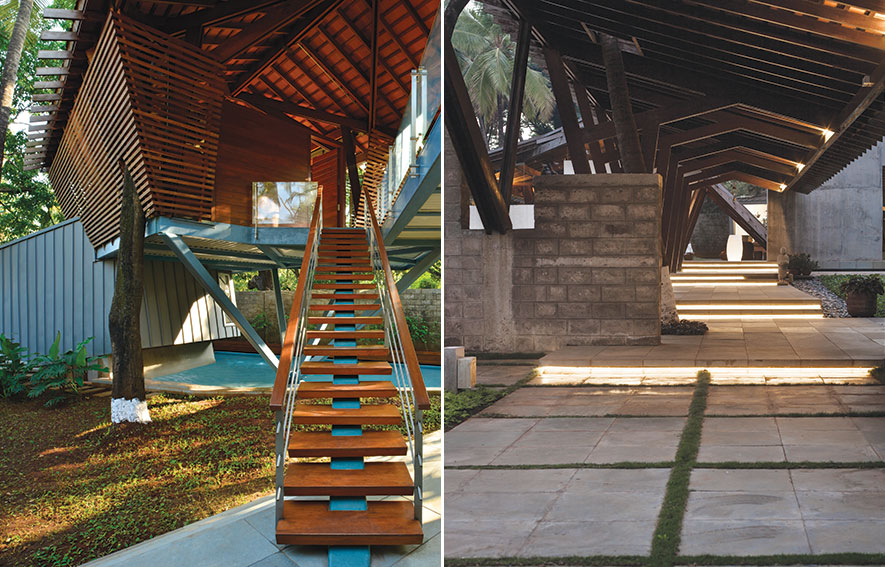
A sweet water column on the site is 6 - 6.5 metres below the ground level. Sweet and salty water have different densities: sweet water is lighter and hence will float over salty water. By doing water harvesting, the ground water table in the surrounding area is increased with sweet water. 'Solution to pollution is dilution' is the concept executed for water harvesting.
Water collected in both the wells is pumped to the main water tank for treatment and used for watering the plants and lawns and for domestic use. The total yield of water is estimated up to 34,500 liters per day. An elaborate water harvesting scheme has been executed on the site.
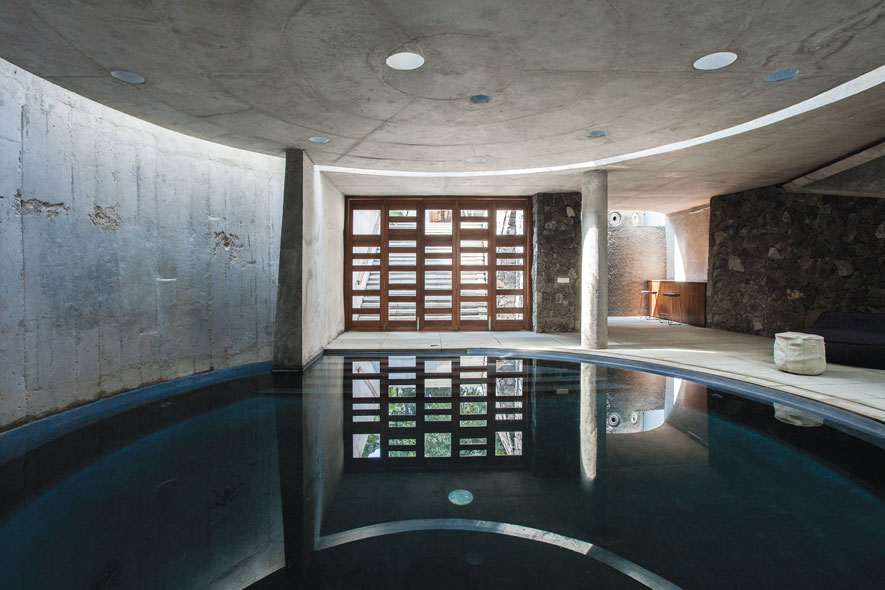 The concept of the hamam has been derived from the stepped wells and Turkish baths
The concept of the hamam has been derived from the stepped wells and Turkish bathsLifestyle enhancing modern rooming elements like the gym, spa, den and home theatre have been segregated using contemporary forms and natural materials like zinc. In sharp contrast to traditional architecture, the articulation for these forms was derived from extruded aluminum sections. These prisms, almost sculpture-like, are perched on either side of the water body that dominates the northern face of the site. Care was taken to ensure natural light and ventilation in each area of the house. Fenestrations included louvers, meshes, and gasket seals to prevent insects, snakes, etc, from entering the rooms.
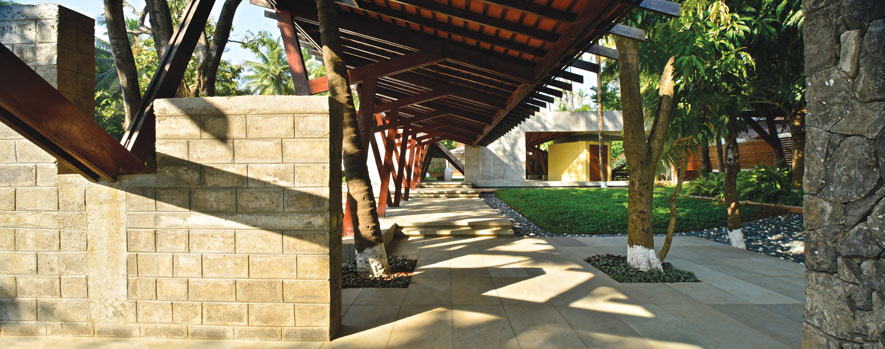 Deeply shaded verandas and semi-outdoor spaces throughout the house balance the indoor and outdoor spaces
Deeply shaded verandas and semi-outdoor spaces throughout the house balance the indoor and outdoor spacesTo make the project more eco-friendly and reduce depletion of natural resources, only locally grown plants have been used in the landscaping to ensure minimum consumption of water. Plenty of natural daylighting, ventilation and use of low emission LED lamps for lighting contribute towards reduced energy load. The water bodies offer both leisure and cooling, while. deeply shaded verandas and semi-outdoor spaces throughout the house balance the indoor and outdoor spaces to create harmony.















